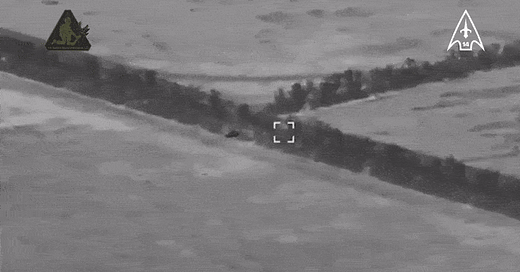Russia's BMP-T Tank Support Vehicle May Be Irrelevant
Changing doctrine, rather than Ukrainian action, has doomed the heavily armed vehicle
A Ukrainian drone regiment has struck one of the Russian army’s rare BMP-T tank support vehicles, making the 53-ton, heavily armed vehicle a little bit rarer. In all across the 34 months of Russia’s wider war on Ukraine, the Ukrainians have hit three other BMP-Ts, destroying one and at least damaging the other two.
The updated tally is four destroyed or damaged BMP-Ts out of the initial production batch of around a dozen that Uralvagonzavod built starting in 2017. It’s possible Uralvagonzavod is working on a second batch of the three-person vehicles, which match a tank chassis with a turret armed with twin 30-millimeter auto-cannons, a coaxial machine gun and quad anti-tank missile launchers.
One confirmed loss for a fleet numbering at least a dozen vehicles isn’t actually very high for Russian forces as the fourth year of their costly war on Ukraine looms.
When Russian losses surpassed 15,000 vehicles and other pieces of heavy equipment recently, some Russian vehicle fleets were down to half or less. It’s likely most of the roughly 4,000 BMP-2 infantry fighting vehicles in service or in storage as of February 2022 are now wrecks littering the 800-mile front line in Ukraine and western Russia.
But it’s possible circumstances, rather than Ukrainian mines, drones, missiles and artillery, are about to render the BMP-T irrelevant if not extinct. The BMP-T’s use case is becoming a thing of the past.
The vehicle’s “array of firepower allows the BMP-T to efficiently destroy a range of battlefield targets, while its powerful chassis makes it as maneuverable and survivable as the tanks it supports,” according to U.S. Army 2nd Lt. E.R. Chesley, writing in a 2020 edition of Armor.
But combined-arms maneuver—tanks, fighting vehicles and specialist vehicles such as the BMP-T supporting each other in coordinated attacks—has fallen out of favor in Russian doctrine as battered Russian regiments have adapted to an increasingly lethal battlefield and slipping training standards.
The standard Russian tactic in the 34th month of the wider war is the so-called “meat assault”: a few dozen under-trained and ambivalently led infantry riding in lightly protected vehicles such as MT-LB tractors or former civilian trucks rushing across no-man’s land, hoping to gain a toehold on the Ukrainian side but expecting heavy losses even if they succeed.
“By employing small, continuous assaults, Russian troops eventually expose and exploit weak points in Ukrainian defenses,” explained Tatarigami, the founder of the Ukrainian analysis group Frontelligence Insight. “While this approach results in high Russian losses, which deemed unsustainable in the long term—it has proven effective in the short to medium term. This sustained pressure has allowed Russian forces to capture key operational strongholds.”
Few in number and expensive for a Russian combat vehicles, the BMP-T is unsuited to this brutal, infantry-first phase of the attritional war in Ukraine. That BMP-T that ate a drone recently, likely around the fortress city of Pokrovsk in eastern Ukraine, was a nice prize for the Ukrainian 14th Separate Unmanned Aerial System Regiment. But taking out a vehicle that’s already irrelevant is mostly a symbolic victory.
Read more:
The Ukrainian M-2 Bradley Force Has Peaked at Six Battalions
For a year or so after receiving the first surplus M-2 Bradley infantry fighting vehicles from the United States, the Ukrainian armed forces assigned the 33-ton, 10-person IFVs to just one unit, the army’s elite 47th Mechanized Brigade.






